Fluid Dynamics
The study of fluids in motion¤ Types of Flow
There are two main types of fluid flow:
-Streamline or Laminar Flow is smooth. It occurs when the water (or other fluid) flows in neat, parallel sheets, and each particle of water follows a smooth path (called a streamline) that doesn't cross the path of the others. This is the kind of flow we would want if we're trying to move through a fluid, because it has little or no drag, and it's what torpedoes, fish, and marine mammals alike are trying to achieve by having a shape similar to the one below.

(If you think this is interesting, check out this cool YouTube video)
-Turbulent Flow involves disturbance and increased drag, and it "is characterized by erratic, small, whirlpool-like circles called eddy currents" that absorb a lot of energy.
(Giancoli, 268)

http://www.youtube.com/watch?v=SJ3w4bg5Tx8
(Giancoli, 268)
http://www.youtube.com/watch?v=SJ3w4bg5Tx8
Which type of flow occurs depends greatly on the Reynold's Number (Re), a dimensionless number that has a lot to do with the fluid you're moving through (eg. air vs syrup) and with your shape (e.g. a clunky cube vs a streamlined torpedo. Think of trying to move these two through water, which do you think would be easier?).
The Reynolds Number is given by the formula:

Where:
µ = the viscosity of the fluid,
V = the velocity of the object,
D = the diameter or length (basically the shape of the object),
ρ =the density of the fluid.
So what does this mean for marine mammals?
Viscosity and density (µ & ρ ) are properties of the fluid, so for our marine mammals these aren't going to change too much because they're always in salt water. That leaves velocity & shape (V & D) as the only things that can be changed if we're trying to achieve laminar flow & avoid wasting energy, but usually, these animals are all "designed" to be able to go fast (think about it, who's gonna leave more descendants, the fast one who can catch all the prey & get away from all the predators, or the slow-poke?), so that leaves us with shape being the main factor, and you can tell, because pretty much every marine mammal is basically shaped like a torpedo, (Horstmann-Dehn, 2012)

(Figure from a scientific paper by Fish et al. from 2008, showing "streamlining in body and control surfaces of a dolphin. Images of cross-sections of flipper, dorsal fin, and flukes were obtained from CT scans. ")
Look at the image below (from p. 16 of Biology of Marine Mammals, by Reynolds & Rommel). It shows the body shapes of several marine mammals compared to a familiar terrestrial mammal, the dog. You can see how streamlined and torpedo-like the bodies of the marine animals are compared to the dog (also note that out of all the marine mammals, the least torpedo-like one is the polar bear, which makes sense because polar bears only diverged from good ol' terrestrial grizzlies about 1mya, and they aren't as marine-adapted -nor do they spend as much time in the water- as the others):
¤ Drag
¤ Bernoulli's Principle


